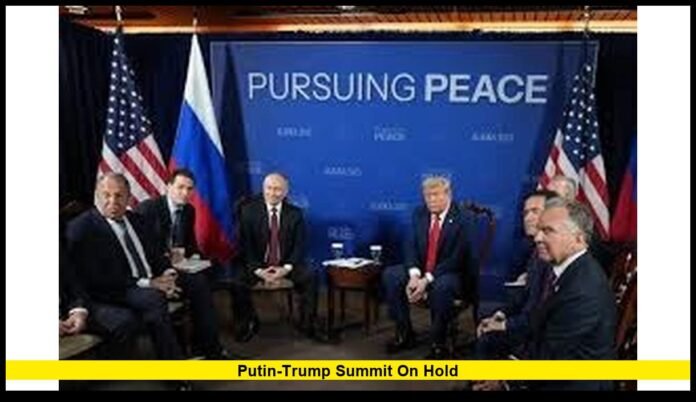The announcement of the Putin-Trump summit on hold marks a significant shift in U.S.–Russia diplomacy. After months of negotiation efforts and public optimism, the planned meeting between President Donald Trump and President Vladimir Putin has been delayed indefinitely due to Russia’s refusal to accept a cease-fire and unwillingness to compromise on key war aims in Ukraine.
The Decision to Postpone the Summit
The U.S. decision to pause the summit follows a pivotal phone call between Secretary of State Marco Rubio and Russian Foreign Minister Sergei Lavrov, during which it became clear that Moscow would not accept a cease-fire based on current front-lines in Ukraine. President Trump stated he would not engage in a “wasted meeting” without meaningful progress on the table. Meanwhile, Moscow reaffirmed that formal recognition of its control over the Donbas region remained non-negotiable—a position incompatible with Washington’s demands.
In Washington, national security officials emphasized that a leader-level meeting was only worthwhile if it offered measurable diplomatic yield. With no date confirmed and preparations stalled, both sides now acknowledge the summit remains on hold.
Why the Summit Was Suspended
Several factors contributed to the decision:
- Russia’s hardline stance: Moscow denied any readiness to halt hostilities unless Ukraine ceded key territory, making a peace deal highly unlikely at this stage.
- U.S. insistence on conditions: The Trump administration emphasized that any summit must be grounded in progress toward peace rather than symbolic optics.
- Allied concerns: Europe and NATO officials signalled that a bilateral U.S.–Russia meeting absent meaningful terms could weaken collective strategy and exclude Ukraine’s role.
- Military escalation: Concurrent to the diplomatic halt, Russia conducted large-scale nuclear drills and intensified attacks on Ukrainian cities, signalling it does not feel pulled toward negotiation yet.
Implications for U.S. Diplomatic Strategy
For the United States, putting the Putin‐Trump summit on hold represents a disciplined recalibration of diplomatic priorities. Rather than pursuing a high-visibility meeting for its own sake, the administration is demanding substance first.
This approach signals to allies and adversaries alike that the U.S. expects concrete commitments—not just photo-ops. By stressing results over ceremony, the U.S. aims to maintain diplomatic leverage while aligning its messaging with European partners.
Russia’s Strategic Response
From Moscow’s perspective, the delay of the summit does little to disrupt its broader strategy. By rejecting cease-fire terms and continuing military operations, Russia underscores its belief that time and attrition favour its goals. The summit being on hold allows the Kremlin to avoid public scrutiny while retaining control of the negotiation pace.
Ukraine’s Position in the Stand-Off
For Kyiv, the decision is cautiously welcomed. Ukrainian leaders and military officials have long warned that a premature summit risked legitimizing Russian demands or marginalizing Ukraine’s interests. The current pause gives Kyiv extra time to reinforce its defenses, secure further support, and enter any future talks from a stronger position.
What Leaders Are Saying
- President Trump: “I don’t want to have a wasted meeting. I don’t want to have a waste of time here. I’ll see what happens.”
- Kremlin spokesman: “All steps will be done in stages; the summit may happen but only after thorough groundwork.”
- European officials: Emphasized that any U.S.–Russia engagement must include Ukraine and avoid undermining allied unity.
Tactical Snapshot: What’s at Play
| Issue | Current Status |
|---|---|
| Summit date | Not scheduled, preparations on hold |
| Cease-fire progress | No agreement; Russia rejects freeze on current front-lines |
| U.S. readiness | Willing to meet only after measurable steps |
| European alignment | Solidly backing Ukraine, warning against summit alone |
| Russian posture | Escalating military activity, testing deterrence |
Broader Consequences
Putting the summit on hold reverberates across several domains:
- Strengthening alliance cohesion: The U.S.’s caution aligns with European allies, reducing risk of a unilateral deal that isolates Ukraine.
- Maintaining negotiation pressure: By delaying, the U.S. can force Russia to act rather than talk.
- Shifting diplomatic optics: The message is clear: leadership meetings must follow progress, not precede it.
- Military-diplomatic interplay: The war remains active even as diplomacy is paused—underscoring that talks and battlefield realities move in tandem.
What to Watch Next
- Whether Russia signals readiness to trim its territorial demands or accept a partial cease-fire.
- If working-level talks begin despite the absence of a summit date.
- How defense assistance to Ukraine evolves while negotiations stall.
- Whether the U.S. or allies set new pre-meeting benchmarks for the Kremlin.
- Any change in Russia’s military posture that might shift the diplomatic calculus.
Why This Matters for U.S. Viewers
For American audiences, this pause reveals a more measured approach to diplomacy—one that refuses to rush into headline-grabbing meetings without substance. The dynamics of U.S.–Russia relations, the fate of Ukraine, and the role of the U.S. as linchpin for allied consensus all remain critical. Keeping the summit on hold opens space for negotiation strength rather than narrative weakness.
With the Putin-Trump summit on hold, the strategic landscape is shifting. If either side moves, the next steps will carry greater weight—and likely far more consequence—than any meeting hurried into for optics alone.
Share your thoughts or reactions below and stay tuned as this story develops.
